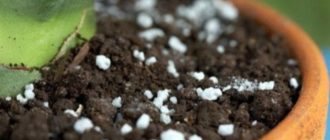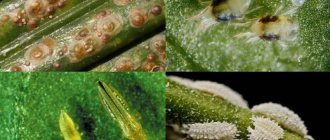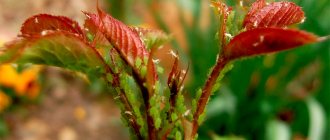Step-by-step instructions on how to get rid of various pests
Arachnoid
After detecting a spider mite on an orchid, you can get rid of it using several methods:
- Biological. It is enough to have several walls of predatory beetles that will destroy adult ticks.
- Chemical. Insecticidal preparations need to be alternated, as parasites develop immunity to the products used. In addition, a one-time treatment will not be enough; it will have to be carried out systematically. The following drugs are effective: Metaldehyde, Thiophos, Actellik.
- Folk. To combat spider mites, you can use a decoction of cyclamen roots. Pour water over the tubers, boil for 30 minutes, leave for 24 hours, and use the resulting filtered liquid to spray the orchid. Carry out treatment every 5 days 3-4 times. Simply wiping the orchid leaves with a cloth soaked in alcohol will help get rid of spider mites.
We invite you to watch a video on how to get rid of spider mites:
Bulbous
As soon as this pest is discovered, it is necessary to immediately change the soil in the pot. You can get rid of bulb mite in the following ways:
- Folk. Using folk remedies is effective only at the early stage of the infection, when the mites have not spread much. A solution of laundry soap is suitable (20 g of raw materials per 1 liter of water). You can use it to wipe orchids or immerse the flower completely in the solution. You can try spraying the plant with a weak solution of potassium permanganate.
- Chemical. Flower growers use general-spectrum insecticides.
But you can also use highly specialized drugs that will only fight ticks - these are acaricides. To prepare the solution, you need to use the instructions indicated on the package. The concentration can be made weaker, but not stronger, otherwise the opposite effect is possible. It is necessary to soak the flower in the prepared solution, and send the roots back into the soil only when they are completely dry.
Root
This parasite is the most difficult and tenacious to remove. It has a high ability to recover and reproduce. If a root mite is noticeable on the orchid, then all affected parts of the flower must be urgently removed, and the cut areas must be treated with activated carbon powder. Affected plants must be isolated from other healthy ones. Throw away the soil immediately and disinfect the pot.
Folk remedies suggest using a nettle decoction, which will not only eliminate pests, but also increase the flower’s immunity.
To prepare the solution, you need to: take 700 g of fresh herb, pour 5 liters of boiling water and leave for 30 minutes in a dark place.
How to treat a plant? This is done within 5 minutes, immersing the entire orchid in the broth. Of the chemical preparations, ascaricides remain effective. You can also use the insectoacaricidal agent Acaritox against pests. Use it strictly according to the instructions, and the frequency of treatment is every 5-7 days.
Biological products are also effective against root mites:
- Verticillin;
- Summer resident;
- Nematophagin.
Flat beetle
To quickly and effectively get rid of the parasite, it is better to immediately use chemicals - acaricides. Since mites are not insects, it is useless to use insecticides.
Most often used:
- Actofik;
- Fitoverm;
- Vermitek.
You can use folk remedies that were given earlier, but they are only effective at the early stage of infection.
Armored
This parasite lives underground, so you need to get rid of it as quickly as possible. To do this, the first step is to remove the flower from the soil and soak the root system in water for half an hour.
3-5 minutes after diving, you will see the parasites begin to emerge. After half an hour, remove the root system from the water and lay it down to dry. Carry out activities 2-3 times to get maximum results. When the roots are dry, you can transplant the plant into new soil. If you use chemical control methods, then acaricidal drugs are effective, including:
- Karbofos;
- Sumiton;
- Aktellik
In the store you can buy a predatory mite - Hypoasmis myles. One package will be enough to completely get rid of parasites.
From the video you can learn how to get rid of armored mites:
Description of types of ticks with photos
The pest belongs to the class of arachnids and has more than a hundred families and 50 thousand species. Only some of them attack indoor plants.
Arachnoid
Changes color depending on the food consumed. As a rule, it takes on a red or green color.
Description:
- abdomen oval, 0.3-0.5 mm;
- loves warmth and dryness. Young individuals develop poorly in high humidity;
- lives in a thin web, multiplies quickly, giving dozens of new generations;
- the moment of maturity occurs 10-20 days after laying eggs. Larvae have 3 pairs of legs;
- life cycle – no more than 4-5 weeks.
White
A representative of the group of spider mites. The body is oval, elongated, sharply tapering towards the posterior end. Size – 0.25-0.43 mm. Lays greenish glassy, spherical eggs. It feeds on the underside of leaves; in places where it is pricked, the tissues become discolored and die.
Red
Very small, about 0.25 mm, inactive, oval, with a red belly, head, and paws.
There are two types:
- Tenuipaltis pacificus – orchidaceous;
- Brevipalpus obovatus – greenhouse mite.
It does not weave a web, so it is difficult to notice. The mite slowly spreads throughout the flower, so visible lesions are a sign of a huge population. Lives on the inside of the plates. Calmly survives high humidity.
Armored
The Oribatidae group of ticks is diverse and contains more than 6 thousand representatives. House plants are attacked by small black insects, 0.2-1.4 mm in size. They live in the substrate - often based on bark, feeding on plant debris and moss. Less common in blocks. They prefer vanda, phalaenopsis, paphiopedilum. Harm comes from catastrophically large colonies.
Bulbous
A large insect with a thickened oval body and two pairs of legs. The color is whitish, cloudy, glassy. Body length – up to 1.1 mm and more. During its life, it lays white, oval eggs. Prefers overfed, abundantly moistened substrate. Turns roots into dust, causing the death of the orchid.
Root
Broadly oval, light yellow, with glossy, smooth skin. The legs are short, thick, with large spines. Length – 0.78-1 mm. Females lay oval white eggs. It feeds on plant tissues of the root system. Very moisture-loving. It quickly thins the roots, turning them into dust. Leaves and flower stalks are damaged. Carrier of fungi and bacteria. If measures are not taken, the orchid will die.
Disease prevention
To prevent mites from appearing on orchids, the following preventive measures must be observed:
- Periodically dry the soil in which the flower grows.
- Spray the flower in a timely manner and ensure that drops of liquid do not stagnate in the axils of the leaves. Otherwise, the orchid will rot.
- Maintain the optimal watering regime.
- Ticks appear in rooms with dry air. You can increase the humidity by placing a container of water at room temperature near the orchid for 2 days. The water will evaporate and the air will become humidified.
After infection with small insects, white or other bugs, mealybugs, scale insects or midges, the orchid begins to slowly die. Regular inspection of all parts, careful care, and regular preventive treatments will help to protect the plant.
Caring for an orchid is very difficult, especially when it comes to pest control. The difficulty is that the flower is attacked by small parasites such as mites. It is not always possible to see them immediately and eliminate them in a timely manner, so you have to resort to more aggressive methods of control when the accumulation of pests is already massive.
What do mites look like on orchids?
Small pests with an elliptical, oval-shaped body, with 4 pairs of legs. Length – 0.1-1.1 mm. Color depends on the type (whitish, black, brick, yellowish). Inconspicuous, they prefer to settle on the lower part of leaf blades, laying eggs along the way. If you do not pay attention to the flower, the population grows to catastrophic proportions.
External signs of infection:
- small depressed gray blotches on the green part of the leaves;
- deformation, drying of the plates along the edges, characteristic silvery coating;
- thin-leaved - curl into a tube, turn yellow, fall off;
- rotten areas at the base of the plant;
- unusually short peduncles, brown spots on deformed flowers;
- web.
Flat beetles
Tenuipalpidae - or false spider mites (not to be confused by name with the flat beetle Cucujidae), of the genus Brevipalpus Brevipalpus and Tenipalpus Tenuipalpus. They are very similar in size and shape to spider mites; they also sit on the underside of leaves and move slowly. Their sizes are very small, from 0.1 to 0.4 mm.
If these images are not enough for you, you can also look at the spider mite photo.
In many species, colonies consist only of females, which hatch from unfertilized eggs. Development occurs in three stages: larva, protonymph and deutonymph. Maturation from egg to adult tick takes 12 to 24 days. The eggs of some species of flat beetles can be seen with the naked eye and appear as clusters of reddish-orange color. Larvae of flat beetles are six-legged, orange-red, translucent, nymphs are opaque, and dark spots appear on the body. Adult ticks are brown, eight-legged, and have a flattened body. Adult females live for 5 - 6 weeks, producing 6-10 generations per season. Many flat beetles have a pause (rest) of 1-2 days between moults; during this time they do not feed and remain motionless on the leaves.
The flat beetles are brown, but very small, looking like brown grains. The puncture sites where the flat beetles are attached are dark dots. Flat beetles do not form webs. They do not suffer from high humidity.
Plants affected by flat beetles differ in the nature of their spots. The fact is that most flat beetles have toxic saliva, which, when it enters plant tissue, causes necrosis. Therefore, brown or gray-brown spots appear on the upper side of the leaf. First small, pinpoint, 1-2 mm, then increasing in size. Leaves are often deformed, and in plants with dense, fleshy leaves (Saintpaulia, Gloxinia), the edges of the leaves begin to turn inward.
Worst of all, flat beetles are the main carriers of viruses (mosaic and ring spot). But what’s even worse is that the ideal conditions for the reproduction of flat beetles are a temperature range of 25-30°C and fairly high air humidity, at least at 70-80% air humidity they are comfortable, while spider mites at such humidity inhibit their development .
Dependence of the rate of mite metamorphosis on temperature:
- at an ambient temperature of 15°C: eggs mature in about 2 weeks, about another week for each subsequent stage: larvae, pronymphs and deutonymphs, a total of 33-36 days from egg to adult.
- at an ambient temperature of 20°C: eggs mature for about a week, about 3 more days for each subsequent stage: larvae, pronymphs and deutonymphs, a total of 2 weeks from egg to adult.
- at an ambient temperature of 30°C: eggs mature in about 3 days, about another 1.5 days for each subsequent stage: larvae, pronymphs and deutonymphs, only a week from egg to adult.
Reasons for appearance
Infection of orchids by mites occurs through the air. Strong winds can carry the larvae of these creatures for many kilometers. In hot, windy weather, the most fertile time comes for ticks to “travel” through nearby surroundings. During the incubation period, humidity is also important - if it is 28-42%, then the parasite will multiply rapidly. As humidity decreases, the development of spider mites slows down.
Spider mites appear on the orchid when there is minimal humidity in the air, this is what provokes the active development of the pest. Mites can completely destroy many house plants in a few days or transform them beyond recognition.
To effectively stop the threat, you need to understand why the parasite appeared. Often, a similar phenomenon occurs when farmers buy seedlings in a store or exchange young plants with each other. Knowing the cause of the orchid disease, it will be easier to eliminate its consequences.











